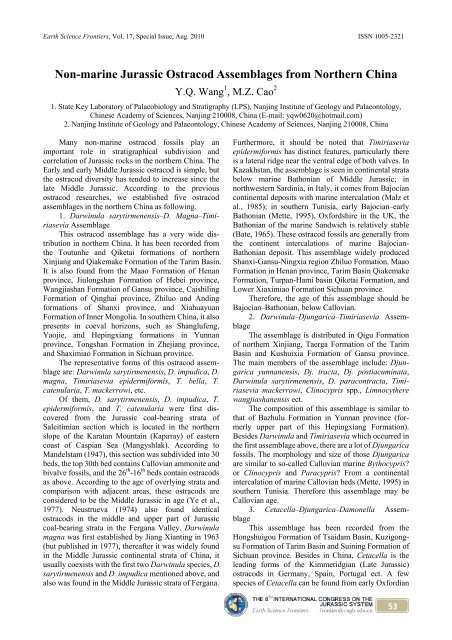in Jurassic and Cretaceous Stratigraphy
in Jurassic and Cretaceous Stratigraphy
in Jurassic and Cretaceous Stratigraphy
You also want an ePaper? Increase the reach of your titles
YUMPU automatically turns print PDFs into web optimized ePapers that Google loves.
Earth Science Frontiers, Vol. 17, Special Issue, Aug. 2010 ISSN 1005-2321<br />
Non-mar<strong>in</strong>e <strong>Jurassic</strong> Ostracod Assemblages from Northern Ch<strong>in</strong>a<br />
Y.Q. Wang 1 , M.Z. Cao 2<br />
1. State Key Laboratory of Palaeobiology <strong>and</strong> <strong>Stratigraphy</strong> (LPS), Nanj<strong>in</strong>g Institute of Geology <strong>and</strong> Palaeontology,<br />
Ch<strong>in</strong>ese Academy of Sciences, Nanj<strong>in</strong>g 210008, Ch<strong>in</strong>a (E-mail: yqw0620@hotmail.com)<br />
2. Nanj<strong>in</strong>g Institute of Geology <strong>and</strong> Palaeontology, Ch<strong>in</strong>ese Academy of Sciences, Nanj<strong>in</strong>g 210008, Ch<strong>in</strong>a<br />
Many non-mar<strong>in</strong>e ostracod fossils play an<br />
important role <strong>in</strong> stratigraphical subdivision <strong>and</strong><br />
correlation of <strong>Jurassic</strong> rocks <strong>in</strong> the northern Ch<strong>in</strong>a. The<br />
Early <strong>and</strong> early Middle <strong>Jurassic</strong> ostracod is simple, but<br />
the ostracod diversity has tended to <strong>in</strong>crease s<strong>in</strong>ce the<br />
late Middle <strong>Jurassic</strong>. Accord<strong>in</strong>g to the previous<br />
ostracod researches, we established five ostracod<br />
assemblages <strong>in</strong> the northern Ch<strong>in</strong>a as follow<strong>in</strong>g.<br />
1. Darw<strong>in</strong>ula sarytirmenensis–D. Magna–Timi-<br />
riasevia Assemblage<br />
This ostracod assemblage has a very wide dis-<br />
tribution <strong>in</strong> northern Ch<strong>in</strong>a. It has been recorded from<br />
the Toutunhe <strong>and</strong> Qiketai formations of northern<br />
X<strong>in</strong>jiang <strong>and</strong> Qiakemake Formation of the Tarim Bas<strong>in</strong>.<br />
It is also found from the Maao Formation of Henan<br />
prov<strong>in</strong>ce, Jiulongshan Formation of Hebei prov<strong>in</strong>ce,<br />
Wangjiashan Formation of Gansu prov<strong>in</strong>ce, Caishil<strong>in</strong>g<br />
Formation of Q<strong>in</strong>ghai prov<strong>in</strong>ce, Zhiluo <strong>and</strong> And<strong>in</strong>g<br />
formations of Shanxi prov<strong>in</strong>ce, <strong>and</strong> Xiahuayuan<br />
Formation of Inner Mongolia. In southern Ch<strong>in</strong>a, it also<br />
presents <strong>in</strong> coeval horizons, such as Shanglufeng,<br />
Yaojie, <strong>and</strong> Hep<strong>in</strong>gxiang formations <strong>in</strong> Yunnan<br />
prov<strong>in</strong>ce, Tongshan Formation <strong>in</strong> Zhejiang prov<strong>in</strong>ce,<br />
<strong>and</strong> Shaximiao Formation <strong>in</strong> Sichuan prov<strong>in</strong>ce.<br />
The representative forms of this ostracod assem-<br />
blage are: Darw<strong>in</strong>ula sarytirmenensis, D. impudica, D.<br />
magna, Timiriasevia epidermiformis, T. bella, T.<br />
catenularia, T. mackerrowi, etc.<br />
Of them, D. sarytirmenensis, D. impudica, T.<br />
epidermiformis, <strong>and</strong> T. catenularia were first dis-<br />
covered from the <strong>Jurassic</strong> coal-bear<strong>in</strong>g strata of<br />
Saleitimian section which is located <strong>in</strong> the northern<br />
slope of the Karatan Mounta<strong>in</strong> (Каратау) of eastern<br />
coast of Caspian Sea (Маngyshlak). Accord<strong>in</strong>g to<br />
M<strong>and</strong>elstam (1947), this section was subdivided <strong>in</strong>to 30<br />
beds, the top 30th bed conta<strong>in</strong>s Callovian ammonite <strong>and</strong><br />
bivalve fossils, <strong>and</strong> the 26 th -16 th beds conta<strong>in</strong> ostracods<br />
as above. Accord<strong>in</strong>g to the age of overly<strong>in</strong>g strata <strong>and</strong><br />
comparison with adjacent areas, these ostracods are<br />
considered to be the Middle <strong>Jurassic</strong> <strong>in</strong> age (Ye et al.,<br />
1977). Neustrueva (1974) also found identical<br />
ostracods <strong>in</strong> the middle <strong>and</strong> upper part of <strong>Jurassic</strong><br />
coal-bear<strong>in</strong>g strata <strong>in</strong> the Fergana Valley. Darw<strong>in</strong>ula<br />
magna was first established by Jiang Xiant<strong>in</strong>g <strong>in</strong> 1963<br />
(but published <strong>in</strong> 1977), thereafter it was widely found<br />
<strong>in</strong> the Middle <strong>Jurassic</strong> cont<strong>in</strong>ental strata of Ch<strong>in</strong>a, it<br />
usually coexists with the first two Darw<strong>in</strong>ula species, D.<br />
sarytirmenensis <strong>and</strong> D. impudica mentioned above, <strong>and</strong><br />
also was found <strong>in</strong> the Middle <strong>Jurassic</strong> strata of Fergana.<br />
Furthermore, it should be noted that Timiriasevia<br />
epidermiformis has dist<strong>in</strong>ct features, particularly there<br />
is a lateral ridge near the ventral edge of both valves. In<br />
Kazakhstan, the assemblage is seen <strong>in</strong> cont<strong>in</strong>ental strata<br />
below mar<strong>in</strong>e Bathonian of Middle <strong>Jurassic</strong>; <strong>in</strong><br />
northwestern Sard<strong>in</strong>ia, <strong>in</strong> Italy, it comes from Bajocian<br />
cont<strong>in</strong>ental deposits with mar<strong>in</strong>e <strong>in</strong>tercalation (Malz et<br />
al., 1985); <strong>in</strong> southern Tunisia, early Bajocian–early<br />
Bathonian (Mette, 1995), Oxfordshire <strong>in</strong> the UK, the<br />
Bathonian of the mar<strong>in</strong>e S<strong>and</strong>wich is relatively stable<br />
(Bate, 1965). These ostracod fossils are generally from<br />
the cont<strong>in</strong>ent <strong>in</strong>tercalations of mar<strong>in</strong>e Bajocian-<br />
Bathonian deposit. This assemblage widely produced<br />
Shanxi-Gansu-N<strong>in</strong>gxia region Zhiluo Formation, Maao<br />
Formation <strong>in</strong> Henan prov<strong>in</strong>ce, Tarim Bas<strong>in</strong> Qiakemake<br />
Formation, Turpan-Hami bas<strong>in</strong> Qiketai Formation, <strong>and</strong><br />
Lower Xiaximiao Formation Sichuan prov<strong>in</strong>ce.<br />
Therefore, the age of this assemblage should be<br />
Bajocian–Bathonian, below Callovian.<br />
2. Darw<strong>in</strong>ula–Djungarica–Timiriasevia Assem-<br />
blage<br />
The assemblage is distributed <strong>in</strong> Qigu Formation<br />
of northern X<strong>in</strong>jiang, Taerga Formation of the Tarim<br />
Bas<strong>in</strong> <strong>and</strong> Kushuixia Formation of Gansu prov<strong>in</strong>ce.<br />
The ma<strong>in</strong> members of the assemblage <strong>in</strong>clude: Djun-<br />
garica yunnanensis, Dj. tracta, Dj. postiacum<strong>in</strong>ata,<br />
Darw<strong>in</strong>ula sarytirmenensis, D. paracontracta, Timi-<br />
riasevia mackerrowi, Cl<strong>in</strong>ocypris spp., Limnocythere<br />
wangjiashanensis ect.<br />
The composition of this assemblage is similar to<br />
that of Bazhulu Formation <strong>in</strong> Yunnan prov<strong>in</strong>ce (for-<br />
merly upper part of this Hep<strong>in</strong>gxiang Formation).<br />
Besides Darw<strong>in</strong>ula <strong>and</strong> Timiriasevia which occurred <strong>in</strong><br />
the first assemblage above, there are a lot of Djungarica<br />
fossils. The morphology <strong>and</strong> size of those Djungarica<br />
are similar to so-called Callovian mar<strong>in</strong>e Bythocypris?<br />
or Cl<strong>in</strong>ocypris <strong>and</strong> Paracypris? From a cont<strong>in</strong>ental<br />
<strong>in</strong>tercalation of mar<strong>in</strong>e Callovian beds (Mette, 1995) <strong>in</strong><br />
southern Tunisia. Therefore this assemblage may be<br />
Callovian age.<br />
3. Cetacella–Djungarica–Damonella Assem-<br />
blage<br />
This assemblage has been recorded from the<br />
Hongshuigou Formation of Tsaidam Bas<strong>in</strong>, Kuzigong-<br />
su Formation of Tarim Bas<strong>in</strong> <strong>and</strong> Su<strong>in</strong><strong>in</strong>g Formation of<br />
Sichuan prov<strong>in</strong>ce. Besides <strong>in</strong> Ch<strong>in</strong>a, Cetacella is the<br />
lead<strong>in</strong>g forms of the Kimmeridgian (Late <strong>Jurassic</strong>)<br />
ostracods <strong>in</strong> Germany, Spa<strong>in</strong>, Portugal ect. A few<br />
species of Cetacella can be found from early Oxfordian<br />
53

















